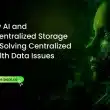Quick Links
- What is DA?
- Challenges in Ethereum’s Data Availability
- Ethereum proposed Danksharding and EIP-4844
- Role of Rollups in Enhancing Data Availability
- Celestia and Avail: Pioneering Data Availability Solutions
- Opportunities for DevelopersTo tackle the data availability problem, developers can focus on building more efficient and scalable data availability layers, such as those implemented by Celestia and Avail. They can develop tools and protocols that support danksharding and EIP-4844, optimizing how data is processed and stored across the network. Additionally, creating innovative roll-up solutions that can seamlessly integrate with existing blockchain infrastructure will be crucial. Developers should also prioritise creating comprehensive monitoring and validation tools to ensure data integrity and availability, providing a robust foundation for decentralised applications.
- So, what’s next?
Imagine trying to construct a puzzle without knowing if all the pieces are present. This analogy captures the essence of data availability: ensuring all information is accessible to verify the complete picture.
The significance of data availability has been recently highlighted by Avail, a data availability network developed by Polygon, which raised $43 million in a Series A funding round. This substantial investment underscored the growing recognition of the critical role that data availability plays in the blockchain ecosystem.
What is DA?
Consider a public library where anyone can check out books. For the library to function properly, it must keep a record of all books and their availability. If some books go missing or their records are inaccurate, the library’s reliability is compromised. In blockchain terms, data availability ensures that every transaction and piece of information in the ledger is accessible and verifiable by all participants, similar to how every book in the library must be accounted for and available. It underpins the trust and reliability of blockchain networks by enabling transparent, secure, and immutable data storage and verification.
Challenges in Ethereum’s Data Availability
Ethereum, the most adopted blockchain infrastructure with over ~ 900K nodes and $100 Bn in TVL, faces significant challenges related to data availability. As the network grows, so does the amount of data that needs to be processed and stored. This growth strains the network’s capacity, leading to issues such as increased costs and slower transaction times. Here are some numbers that highlight these challenges:
- Transaction Costs: The average transaction fee on Ethereum skyrocketed to over $60 during peak periods in 2021.
- Storage Requirements: Ethereum’s blockchain size is over 1 TB and growing, making it increasingly difficult for nodes to store and verify the entire blockchain.
These challenges stem from the fundamental requirement for every node in the network to download and verify all transactions, which becomes impractical as the network scales.
Ethereum proposed Danksharding and EIP-4844
To address these data availability issues, Ethereum is implementing a new approach, danksharding, encapsulated in Ethereum Improvement Proposal (EIP) 4844. It aims to improve scalability by restructuring how data is processed and stored.
What is Danksharding?
Danksharding, named after Ethereum researcher Dankrad Feist, introduces a novel way to handle data availability. Instead of requiring every node to process all data, it allows data to be split into smaller, manageable pieces (shards). Each shard is responsible for a subset of the data, and only a portion of nodes (validators) need to check the availability of these shards.
EIP-4844: Proto-Danksharding
EIP-4844, also known as Proto-Danksharding, is the first step towards implementing danksharding. It introduces “blob-carrying transactions,” which are large chunks of data attached to regular transactions. These blobs are designed to be less expensive and more efficient to process, significantly reducing the storage burden on nodes. Key benefits include:
- Increased Throughput: The network can handle more transactions per second by enabling more data to be processed in parallel. For example, EIP-4844 is expected to increase Ethereum’s throughput by up to 100 times.
- Lower Costs: Efficient data processing reduces transaction fees, making the network more accessible. With these improvements, transaction fees could drop by as much as 90%.
- Enhanced Scalability: The approach allows the network to scale sustainably as demand grows.
Role of Rollups in Enhancing Data Availability
Rollups are a layer 2 solution that bundles multiple transactions into a single batch, which is then posted to the Ethereum main chain. This approach significantly reduces the amount of data that needs to be processed on-chain, enhancing data availability.
Rollups play a crucial role in addressing data availability by offloading much of the transaction processing to off-chain solutions, reducing the burden on the main Ethereum chain.
Celestia and Avail: Pioneering Data Availability Solutions
Celestia and Avail are two innovative projects addressing the data availability problem in unique ways.
Celestia
Celestia is a modular blockchain network that decouples consensus from data availability and execution. By separating these functions, Celestia can scale more efficiently and provide robust data availability guarantees. Celestia’s approach allows for more specialized and efficient blockchains that handle data availability independently from transaction processing.
Avail
Avail, a spinoff from Polygon, focuses on providing a scalable and efficient data availability layer specifically designed for rollups and other layer 2 solutions. Avail aims to offer a universal data availability solution integrated with various blockchain networks, enhancing their scalability and security.
Key Benefits
- Scalability: Both Celestia and Avail enable higher transaction throughput by optimizing how data is stored and accessed. Celestia, for example, can potentially increase throughput by several orders of magnitude by leveraging its modular approach.
- Security: By ensuring data availability, these solutions enhance the overall security and integrity of blockchain networks.
Opportunities for Developers
To tackle the data availability problem, developers can focus on building more efficient and scalable data availability layers, such as those implemented by Celestia and Avail. They can develop tools and protocols that support danksharding and EIP-4844, optimizing how data is processed and stored across the network. Additionally, creating innovative roll-up solutions that can seamlessly integrate with existing blockchain infrastructure will be crucial. Developers should also prioritise creating comprehensive monitoring and validation tools to ensure data integrity and availability, providing a robust foundation for decentralised applications.
So, what’s next?
While more glamorous aspects of blockchain technology often overshadow data availability, its importance cannot be overstated. Ignoring this critical issue is a recipe for disaster, risking the very foundation of blockchain security and scalability. As Ethereum continues to evolve, addressing data availability challenges through innovations like danksharding and EIP-4844 is critical for its scalability and efficiency. Rollups, Celestia, and Avail offer promising solutions to enhance data availability, reduce costs, and improve transaction throughput.









